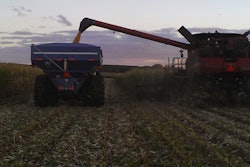
heat is a building block of mankind. Researchers in Egypt have found loaves from 5,000 years ago, and it allowed communities to develop as people found alternatives to relying on a nomadic hunter/gathering existence. Wheat is a good source of vegetable protein, it stores well, and its straw provides bedding and helps build bricks. Socrates even recognized the importance of wheat: “No man qualifies as a statesman who is entirely ignorant on the problems of wheat.”
But wheat isn’t a perfect crop. Modern hybrids have raised yields, but those still haven’t eliminated worrisome issues that have long plagued wheat, including vomitoxin, rust, karnal bunt, scab, ergot and simple sprout or freeze damage.
Wheat is generally a hardy crop but this year is testing that premise. Last year Central Plains farmers prayed for rain to break the extreme drought that slashed their hard red wheat crops. Now even while they were saying “thanks” for this year’s widespread rains, Mother Nature turned down the temperature and kept the spigot running, which can lead to rust problems. Ohio Valley and Delta farmers have also struggled since early spring under heavy rains which could threaten the quality of millions of their soft red wheat acres with vomitoxin for the second year in a row. Central Texas farmers fared well last year with good production and big yields, only to see 2015’s wheat starting to sprout in the field weeks before harvest. Kansas and Oklahoma farmers also face yield loss from the earlier freezes.
Around the world, parts of the Former Soviet Union’s breadbasket struggled through a poor 2014 fall planting season and have now turned dry. Parts of Canada are also too dry while India may shift from being a net wheat exporter to an importer after spring rains have slashed 2015 wheat prospects. Overall, global wheat production in 2015 is already forecast to fall 1%, by about 8 million tonnes. But beginning 2015 world stocks will be 11 million tonnes higher than last year, and 2016 ending stocks are still forecast to rise to a five-year high 104 days’ worth.
Record wheat production around the world two years running plus the strong U.S. dollar have combined to hold down U.S. wheat exports which helped turn the speculative sector bearish in 2014. Managed fund net longs in wheat futures hit their most recent peak over a year ago, sliding steadily until they reached record net shorts in recent months, taking wheat futures to five-year lows. Funds were net short almost 110,000 contracts, or 550M bushels, in CBT wheat in recent weeks, more than the entire U.S. SRW crop. But the story is more complex: Some funds were long while those that were short totaled 158,000 contracts, or 35% of all shorts in CBOT wheat. Not only are the funds short, they’re short almost four times the short hedges held by the commercial side. The numbers are smaller in KC wheat: Funds were short about 40,000 contracts recently with others long about 30,000, for a net short around 10K contracts. Those 40K short contracts, though, account for 24% of the total open interest in KC wheat futures.
Wheat futures have shown explosive potential in past crop scares. In 2012 wheat rallied more than $3 in just a few months. Back in 2002 wheat broke out of a four-year 40-cent sideways range with a rally of almost $2 over several months. The concerns about U.S. winter wheat led to fund buying in May that pushed wheat futures up more than 10% in three weeks, yet funds continue to be near record net short. Futures could surge much higher this year if those funds all decide to liquidate their short positions in the face of crop concerns. But dramatic breaks have often followed past run-ups and caution is again in order.
Global wheat supplies remain adequate and the U.S. dollar remains near 10-year highs. The U.S. wheat problems in 2015 look to be more about quality than quantity. Quality issues can be managed through market discounts, and basis, more than by any real need for sustained higher prices.
Discounts for low test weight are already rising in hard red wheat markets, and sellers may find themselves hard-pressed to move sprout-damaged wheat into export channels where anything more than 7% damage grades the wheat as #4.
Vomitoxin isn’t often seen in the Plains but it flourishes in wet conditions, and Western elevators need to brush up on the standards and testing procedures to be ready –- just in case.
- FDA standards require raw wheat destined for human consumption to test 1 ppm vomitoxin or lower.
- The export market typically caps allowable vomitoxin at 2 ppm.
- Feed wheat is allowed 10ppm for poultry and ruminant and feedlot beef more than 4 months of age.
- Swine can only be fed up to 5 ppm.
Soft red wheat (SRW) areas, have seen a lot of high vomitoxin in recent years, and there are many millions of bushels of “vomo” wheat that remain in bins right now. This wheat will be carried into 2015 crop for blending to be marketable. A significant amount is held in bins from the Delta up into the Ohio Valley — much of which would typically move for export through the Gulf. The problem is that the total current book of SRW export sales is just 36M bushels. A lot of river barge stations already own stocks of vomitoxin wheat, and some have already indicated they can’t take in more this harvest. The SRW basis could suffer in these river markets as elevators try to move both old and new wheat this season into a reduced export market, and vomitoxin discount schedules could soar.
Vomitoxin can also affect CBOT wheat futures spreads. Mills and other quality buyers won’t buy and take delivery of wheat futures if they believe the stocks in Chicago and other delivery locations contain much vomitoxin. The current CBOT rules limit vomitoxin on delivery load-outs to a maximum “3 ppm.” Rule 14104 states as follows:
“Effective September 1, 2013 ... all wheat shipping certificates shall be marked as either 2 ppm deoxynivalenol (vomitoxin), or 3 ppm vomitoxin. Shipping certificates marked as 2 ppm vomitoxin shall be delivered at contract price, while shipping certificates marked as 3 ppm shall be delivered at a 20 cent/bushel discount. A taker of delivery of wheat shall have the option to request in writing vomitoxin testing. At the taker’s expense, a determination of the level of vomitoxin shall be made at the point of load-out by the Federal Grain Inspection Service or by a third-party inspection service which is mutually agreeable to the maker and taker of delivery. Regular facilities shall load out wheat containing unit average testing results of 2 ppm vomitoxin or below for canceled shipping certificates marked as 2 ppm and shall load out wheat containing unit average testing results of 3 ppm vomitoxin or below for canceled shipping certificates marked as 3 ppm.”
The KCBT rule book states as follows:
“Deoxynivalenol (also known as Vomitoxin) Restriction:
When electronic warehouse receipts are surrendered to the issuer for load-out pursuant to Rule 14H13, the taker of delivery shall have the option to, at taker’s expense, request in such written load-out instructions that the wheat contain no more than 2 ppm of deoxynivalenol (vomitoxin). A determination of the level of deoxynivalenol shall be made at the point of origin by the Federal Grain Inspection Service or such other third-party inspection service mutually agreeable to the maker and taker of delivery. The determination of the level of deoxynivalenol shall be based on the average test results of the wheat loaded in a single day from a single warehouse for each taker of delivery. As of the effective date of this rule (September 1, 2011), any electronic warehouse receipts previously issued and outstanding shall be subject to the provisions of this Rule.”
A problem arose this spring regarding load-out against CBT SRW futures delivery certificates. The load out orders were written as containing maximum “3 ppm vomitoxin.” The buyer (taker) discovered upon load-out that if the order states “3”, then FGIS will round any vomitoxin test results either up or down. Therefore an actual reading of up to 3.4 ppm would be officially graded as “3 ppm” which meets the delivery specification. But if the load-out order showed “max 3.0 ppm vomitoxin,” the FGIS inspector would mark the inspection certificate to the exact 1/10 ppm on vomitoxin.
Then buyer/taker of the load-out objected but did not prevail after FGIS marked the grade as “3 ppm.” The firm raised the issue with CME Group, and CME staff are now reviewing the rule book language and working on a clarification. The likely resolution would amend Regulation 14104 to indicate that vomitoxin of up to 2.0 ppm would be deliverable at contract price, 2.1 to 3.0 would be deliverable at a 20- cent discount to contract price; with 3.1 or higher not allowed. CME staff is investigating whether resolving the issue this way would also require review or approval by the CFTC.
Whether vomitoxin is 3.2 or 3 on a futures delivery may sound nit-picky, but the precise level allowed on deliveries can impact futures spreads. Higher vomitoxin will reduce the interest by long/takers and has the potential — when vomitoxin is an issue — to widen futures carries during the delivery month. Basis would then do the work of finding the correct quality wheat for buyers.
This will be a wheat harvest where managers that are diligent about testing inbound wheat and grading and discounting accordingly may save themselves a mountain of headaches later.
Subscribe to Magazine



















